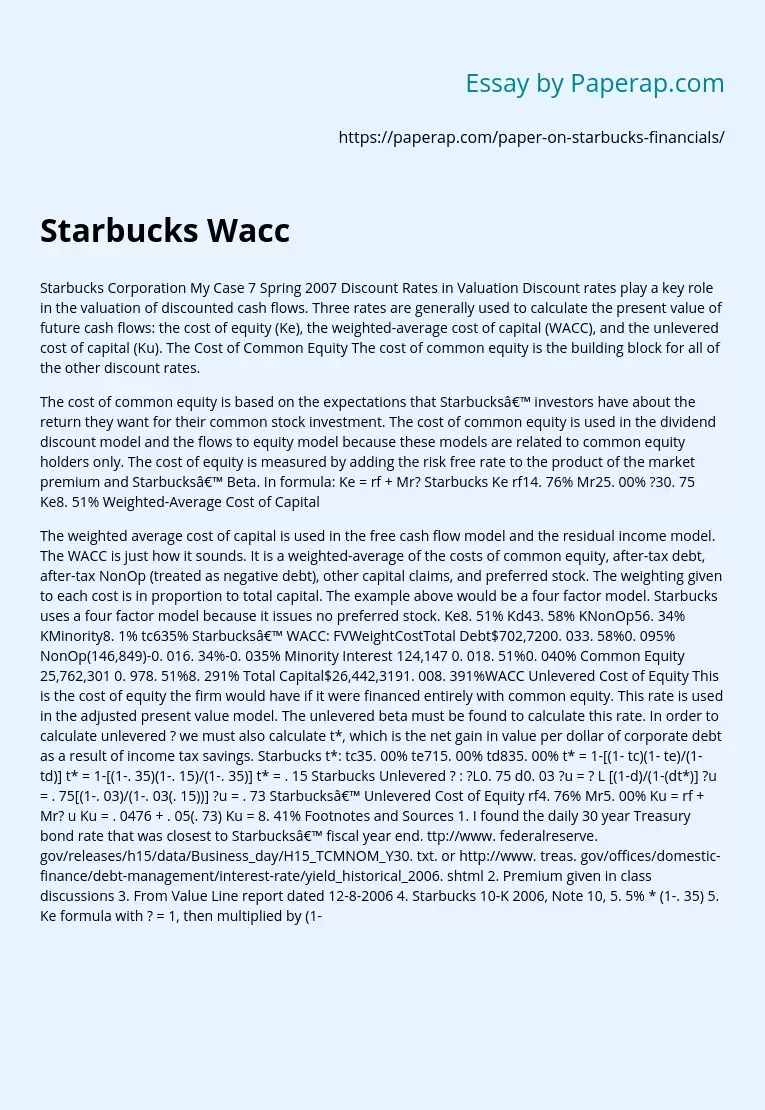Starbucks Corporation Wacc Financials
Starbucks Corporation My Case 7 Spring 2007 Discount Rates in Valuation Discount rates play a key role in the valuation of discounted cash flows. Three rates are generally used to calculate the present value of future cash flows: the cost of equity (Ke), the weighted-average cost of capital (WACC), and the unlevered cost of capital (Ku). The Cost of Common Equity The cost of common equity is the building block for all of the other discount rates.
The cost of common equity is based on the expectations that Starbucks’ investors have about the return they want for their common stock investment.
The cost of common equity is used in the dividend discount model and the flows to equity model because these models are related to common equity holders only. The cost of equity is measured by adding the risk free rate to the product of the market premium and Starbucks’ Beta. In formula: Ke = rf + Mr? Starbucks Ke rf14. 76% Mr25. 00% ?30. 75 Ke8. 51% Weighted-Average Cost of Capital
The weighted average cost of capital is used in the free cash flow model and the residual income model.
The WACC is just how it sounds. It is a weighted-average of the costs of common equity, after-tax debt, after-tax NonOp (treated as negative debt), other capital claims, and preferred stock. The weighting given to each cost is in proportion to total capital. The example above would be a four factor model. Starbucks uses a four factor model because it issues no preferred stock. Ke8. 51% Kd43. 58% KNonOp56. 34% KMinority8. 1% tc635% Starbucks’ WACC: FVWeightCostTotal Debt2,7200.
033. 58%0. 095% NonOp(146,849)-0. 016. 34%-0. 035% Minority Interest 124,147 0. 018. 51%0. 040% Common Equity 25,762,301 0. 978. 51%8. 291% Total Capital$26,442,3191. 008. 391%WACC Unlevered Cost of Equity This is the cost of equity the firm would have if it were financed entirely with common equity. This rate is used in the adjusted present value model. The unlevered beta must be found to calculate this rate. In order to calculate unlevered ? we must also calculate t*, which is the net gain in value per dollar of corporate debt as a result of income tax savings. Starbucks t*: tc35. 00% te715. 00% td835. 00% t* = 1-[(1- tc)(1- te)/(1- td)] t* = 1-[(1-. 35)(1-. 15)/(1-. 35)] t* = . 15 Starbucks Unlevered ? : ?L0. 75 d0. 03 ?u = ? L [(1-d)/(1-(dt*)] ?u = . 75[(1-. 03)/(1-. 03(. 15))] ?u = . 73 Starbucks’ Unlevered Cost of Equity rf4. 76% Mr5. 00% Ku = rf + Mr? u Ku = . 0476 + . 05(. 73) Ku = 8. 41% Footnotes and Sources 1. I found the daily 30 year Treasury bond rate that was closest to Starbucks’ fiscal year end. ttp://www. federalreserve. gov/releases/h15/data/Business_day/H15_TCMNOM_Y30. txt. or http://www. treas. gov/offices/domestic-finance/debt-management/interest-rate/yield_historical_2006. shtml 2. Premium given in class discussions 3. From Value Line report dated 12-8-2006 4. Starbucks 10-K 2006, Note 10, 5. 5% * (1-. 35) 5. Ke formula with ? = 1, then multiplied by (1-. 35) 6. Corporate marginal tax rate from class 7. Capital gains tax rate from class 8. Individual marginal tax rate from class
Starbucks Financial Analysis Essay
Starbucks Corporation Wacc Financials. (2019, Dec 05). Retrieved from https://paperap.com/paper-on-starbucks-financials/

